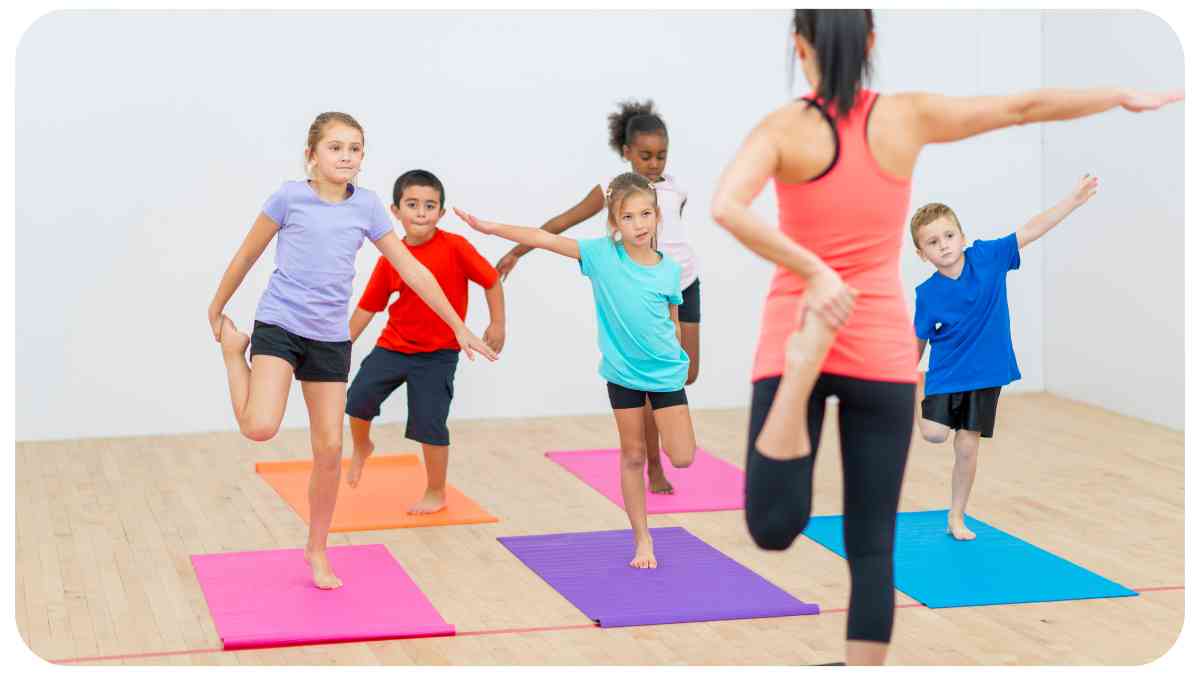Welcome to our comprehensive guide on the practice of yoga and mindfulness for kids. In an increasingly fast-paced world, children often face various challenges that may impact their overall well-being. Yoga and mindfulness offer effective tools for children to find balance, build resilience, and develop essential life skills.
This article will explore the numerous benefits of yoga and mindfulness for kids, discuss different techniques that can be utilized, offer practical tips for parents, and address potential challenges faced when introducing these practices to children.
As a parent and experienced yoga instructor, I have witnessed firsthand the positive impact of yoga and mindfulness on children. By integrating my personal experiences with my expertise in the field, I aim to provide actionable advice and insights that will empower parents to embark on this transformative journey with their children.
| Takeaways |
|---|
| 1. Incorporate yoga and mindfulness into daily routines |
| 2. Lead by example and practice alongside your child |
| 3. Create a calming wind-down routine before bedtime |
| 4. Use transitions as opportunities for mindfulness breaks |
| 5. Teach your child to use yoga and mindfulness during challenging moments |
So, let’s dive in and discover what yoga and mindfulness can do for your kids!
2. The Benefits of Yoga and Mindfulness for Kids
Yoga and mindfulness offer a wide range of benefits for children, both physically and mentally. Incorporating these practices into their lives can have a profound impact on their overall well-being. Let’s explore some of the key benefits:
Understanding the differences between Yin Yoga and Hatha Yoga is essential for a well-rounded yoga practice. Discover the benefits of each style in our guide on Yin Yoga vs Hatha Yoga, and find out if you need both in your routine.
How Yoga and Mindfulness Promote Physical Health
2.1 Improved Flexibility and Strength
Yoga involves various stretching and strengthening exercises that promote flexibility and improve muscle tone.
Regular practice can help children develop better posture and body awareness, reducing the risk of musculoskeletal issues later in life. It also enhances their coordination and balance, making them more adept at physical activities.
Table 1: Yoga Poses for Flexibility and Strength
| Pose | Description |
| Downward Facing Dog | Strengthens arms, shoulders, and stretches the hamstrings |
| Tree Pose | Enhances balance and strengthens leg muscles |
| Cobra Pose | Opens the chest and strengthens the back muscles |
2.2 Enhancing Balance and Coordination
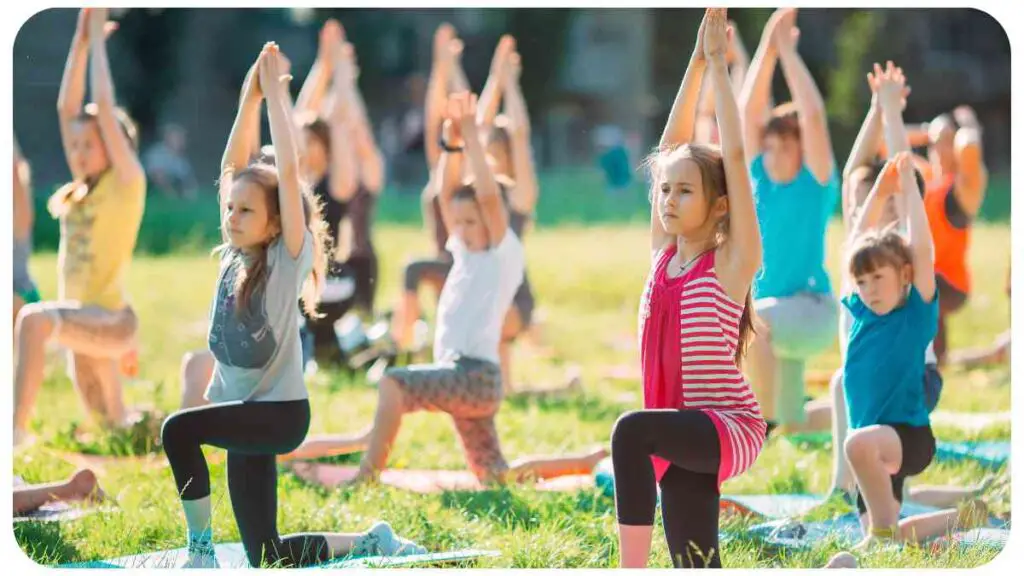
Yoga poses require children to focus on their body movements and maintain balance. By practicing balancing postures, they improve their coordination and stability. This improved sense of balance can extend to other physical activities, such as sports and dance.
Table 2: Yoga Poses for Balance and Coordination
| Pose | Description |
| Warrior III | Develops balance and strengthens leg muscles |
| Eagle Pose | Enhances focus and improves balance |
| Dancer’s Pose | Increases body awareness and improves balance |
Boosting Mental Well-being through Yoga and Mindfulness
2.3 Developing Emotional Awareness and Regulation
Yoga and mindfulness practices encourage children to connect with their emotions and cultivate emotional intelligence.
Through various techniques like deep breathing and guided visualizations, kids learn to recognize and manage their feelings in a healthy way. This emotional awareness helps them navigate challenging situations with greater ease and promotes mental resilience.
Table 3: Breathing Exercises for Emotional Regulation
| Exercise | Description |
| Balloon Breath | Inhale deeply, imagining your belly as a balloon. Exhale slowly, deflating it |
| Calm Counting | Inhale deeply, count to four; exhale slowly, count to four |
| Bunny Breath | Inhale through the nose, exhale through the mouth like a bunny sniffing air |
2.4 Reducing Stress and Anxiety
In today’s fast-paced world, children often experience stress and anxiety. Yoga and mindfulness provide effective tools to help children manage these feelings.
Deep breathing exercises, yoga poses, and mindfulness techniques help activate the body’s relaxation response, reducing stress levels. Regular practice can equip children with coping mechanisms to face challenges with calmness and resilience.
Table 4: Mindfulness Techniques for Stress Reduction
| Technique | Description |
| Body Scan | Bring attention to different parts of the body, releasing tension |
| Loving-Kindness | Cultivate feelings of kindness and compassion towards oneself and others |
| Mindful Walking | Engage in walking with awareness, focusing on each step and sensation |
3. Yoga and Mindfulness Techniques for Kids
Now that we’ve explored the benefits of yoga and mindfulness for children, let’s dive into some specific techniques that can be incorporated into their daily lives. These techniques are designed to be fun, engaging, and age-appropriate for kids.
3.1 Breathing Exercises
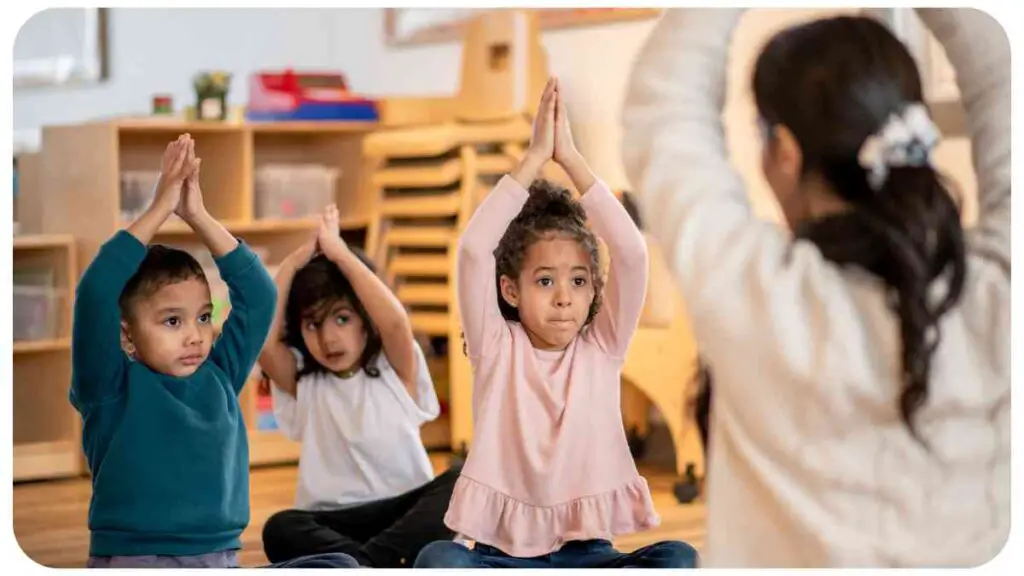
Teaching children proper breathing techniques can help them manage their emotions, reduce stress, and promote relaxation. Here are a few breathing exercises that you can introduce to your child:
Table 5: Breathing Exercises for Kids
| Exercise | Description |
| Bubble Breaths | Inhale through the nose, then blow out slowly through pursed lips, creating bubbles |
| Pretzel Breath | Inhale, while twisting the torso to one side, and exhale while twisting to the other side |
| Ocean Breath | Inhale deeply, then exhale with a “haa” sound, imagining the breath as ocean waves |
3.2 Mindful Movement
Engaging children in mindful movement activities can help improve their concentration, body awareness, and balance. These activities can be incorporated into daily routines or practiced as short movement breaks. Here are a few examples:
Cultivating mindfulness can significantly enhance your emotional well-being. Explore our 15 simple mindfulness practices, designed to bring balance to your life. Check out our guide on 15 Simple Mindfulness Practices and start your journey towards a more peaceful mind.
Table 6: Mindful Movement Activities for Kids
| Activity | Description |
| Animal Walks | Encourage your child to imitate different animals in their movement, such as crab walks or frog jumps |
| Yoga Dance | Create a fun and energetic sequence of yoga poses combined with dance movements |
| Nature Walk | Take a mindful walk together, observing and appreciating the sights, sounds, and textures of nature |
3.3 Guided Visualizations
Guided visualizations help children develop their imagination and focus while promoting relaxation and self-awareness. These visualizations can transport them to peaceful and calming environments. Here are a few examples:
Table 7: Guided Visualizations for Kids
| Visualization | Description |
| Bubble Bath | Imagine taking a soothing bubble bath, feeling the warmth and relaxation seeping in |
| Magic Garden | Visualize being in a beautiful garden, surrounded by vibrant flowers and butterflies |
| Starry Night | Picture lying on the grass under a starry night sky, feeling serene and peaceful |
3.4 Yoga Poses
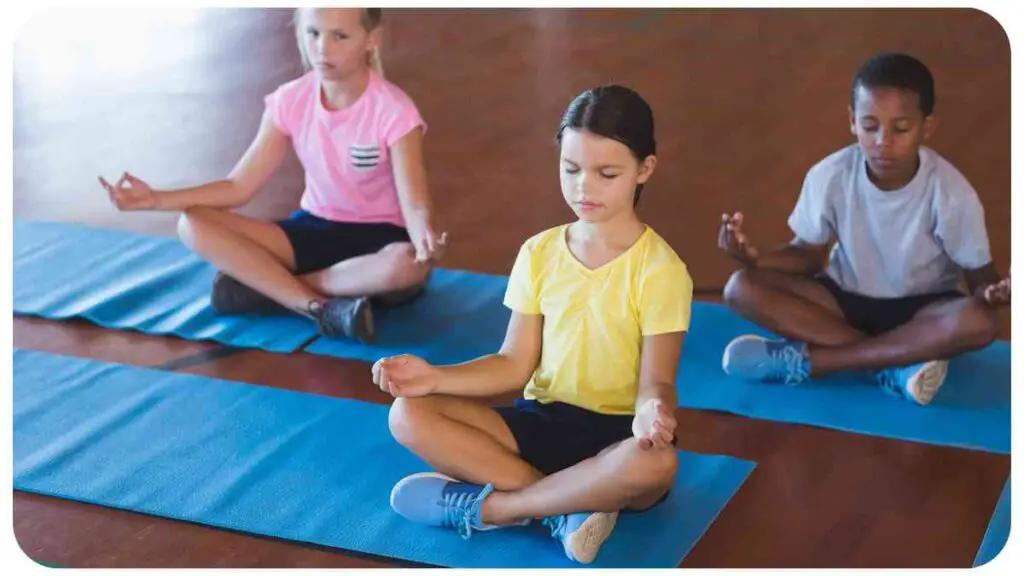
Yoga poses are an integral part of any yoga practice. They enhance strength, flexibility, and body awareness while promoting mindfulness. Here are a few fundamental yoga poses to get your child started:
Table 8: Yoga Poses for Kids
| Pose | Description |
| Cat-Cow | Move between rounding the spine and arching it like a cat |
| Tree Pose | Stand tall with one foot rooted on the ground and balance on one leg, with arms stretched upwards |
| Child’s Pose | Kneel down, sitting on your heels, and fold your body forward, resting your forehead on the ground |
4. Creating an Enriching Yoga and Mindfulness Practice Environment
To fully embrace the benefits of yoga and mindfulness, it is essential to create a supportive and enriching environment for your child. Here are some suggestions to enhance their practice:
4.1 Designating a Calm and Quiet Space
Set aside a dedicated area in your home where your child can practice yoga and mindfulness. This space should be quiet, clean, and free from distractions. Use soft lighting and decorate the area with calming elements like plants, cushions, or a beautiful tapestry.
Harness the transformative power of yoga and movement therapy to bid farewell to stress and anxiety. Dive into our guide on Say Goodbye to Stress and Anxiety and discover the holistic practices that can bring peace and harmony to your life
4.2 Utilizing Props and Accessories
Introduce yoga props and accessories to make the practice more engaging and enjoyable. Yoga mats, blocks, straps, and bolsters can help children maintain proper alignment in poses and ensure their safety. Consider incorporating playful props like stuffed animals or visual aids to make the sessions more interactive.
Table 9: Yoga Props and Accessories
| Prop/Accessory | Description |
| Yoga Mat | Provides a non-slip surface for practicing yoga poses |
| Yoga Blocks | Assists in maintaining proper alignment and support in challenging poses |
| Eye Pillow | Enhances relaxation during restorative poses and meditation |
4.3 Tapping into Digital Resources and Applications
In today’s digital age, several websites and apps offer yoga and mindfulness practices specifically designed for children. These resources often include videos, guided meditations, and fun interactive games. Utilizing these tools can make the practice more accessible and enjoyable for your child.
Table 10: Digital Resources for Kids’ Yoga and Mindfulness
| Resource | Description |
| Cosmic Kids Yoga | Provides yoga adventures through storytelling, incorporating themes from popular children’s books |
| Smiling Mind | Offers guided mindfulness exercises and meditation practices designed for different age groups |
| GoNoodle | Provides interactive movement and mindfulness activities, often used in schools to energize children |
5. Incorporating Yoga and Mindfulness into Daily Routines
Integrating yoga and mindfulness into daily routines can help make these practices a consistent part of your child’s life. Here are some suggestions for incorporating them seamlessly:
5.1 Morning Wake-Up Routine
Start the day with a gentle and energizing yoga routine to awaken your child’s mind and body. Encourage them to stretch their muscles, take deep breaths, and set positive intentions for the day ahead. This can help them feel centered and focused as they begin their daily activities.
5.2 Pre-Bedtime Wind-Down Routine
Incorporate a calming wind-down routine before bedtime to help your child relax and prepare for sleep. This can include gentle yoga stretches, breathing exercises, and guided visualizations. By creating a soothing evening ritual, you can promote better sleep quality and a peaceful transition into dreamland.
Embracing mindfulness is an act of self-care that nurtures your mind and body simultaneously. Learn more about the vital connection between mindfulness and self-care in our comprehensive guide on Mindfulness and Self-Care. Prioritize your well-being and unlock a path to inner balance.
5.3 Transition Time between Activities
Encourage your child to take short mindfulness breaks during transitions between activities. For example, before starting homework or moving from playtime to study time, practice a quick breathing exercise or engage in a mindful movement activity. This can help them shift their focus, enhance concentration, and reduce stress.
5.4 Practice during Challenging Moments
Teach your child to utilize yoga and mindfulness techniques during moments of frustration, stress, or overwhelm. Encourage them to take deep breaths or step away for a few minutes to engage in a simple grounding exercise.
By incorporating these practices during challenging moments, they can develop emotional resilience and self-regulation skills.
6. Tips for Parents to Support their Children’s Yoga and Mindfulness Journey
As a parent, you play a crucial role in supporting and nurturing your child’s yoga and mindfulness journey. Here are some tips to help you create a positive and supportive environment:
6.1 Lead by Example
Children learn best by observing and imitating their parents. Practice yoga and mindfulness yourself to be a role model for your child. Let them witness your commitment and enthusiasm towards these practices. Your involvement will inspire and encourage them to follow suit.
6.2 Encourage Consistency
Consistency is key when it comes to yoga and mindfulness. Encourage your child to practice regularly, even if it’s just a few minutes each day. Set a routine that works for both you and your child, and stick to it as much as possible. Consistency will help them experience the full benefits of these practices over time.
Breath is the essence of yoga, and understanding pranayama can deepen your practice. Discover the significance of breath work in our guide on The Importance of Breath in Yoga. Explore various techniques and unlock the power of intentional breathing for a more enriching yoga experience.
6.3 Make it Fun and Interactive
Make yoga and mindfulness enjoyable by incorporating games, storytelling, and creative elements into the practice. Use props, music, or themed yoga sequences to keep your child engaged and excited. The more fun they have, the more likely they are to continue practicing.
6.4 Allow for Personalization and Choice
Give your child the freedom to choose the style of yoga or mindfulness that resonates with them. Some children may prefer dynamic and energetic practices, while others may enjoy calming and restorative activities. Let them explore different techniques and find what brings them joy and peace.
7. Tracking Progress and Celebrating Achievements
Tracking your child’s progress and celebrating their achievements can provide motivation and encouragement to continue their yoga and mindfulness journey. Here are some ways to do so:
7.1 Journaling
Encourage your child to keep a yoga and mindfulness journal where they can reflect on their practice. They can write about how they felt during their practice, their favorite poses or techniques, and any insights or breakthroughs they experienced. This journal can serve as a valuable tool for self-reflection and a record of their progress.
7.2 Creating a Progress Chart
Design a fun and visual progress chart where your child can track their practice. Use stickers, colors, or checkmarks to mark each day they engage in yoga or mindfulness. This visual representation can help them see their commitment and progress over time, providing a sense of accomplishment.
7.3 Setting and Celebrating Goals
Help your child set realistic and achievable goals related to yoga and mindfulness. It could be mastering a new pose, increasing their meditation time, or practicing consistently for a certain period.
Celebrate their milestones with praise, small rewards, or special activities that they enjoy. This positive reinforcement will keep them motivated and eager to continue their practice.
7.4 Sharing and Practicing Together
Encourage your child to share their progress and achievements with family members or friends. They can demonstrate a new yoga pose or lead a mindfulness activity for others to join. Sharing their practice not only boosts their confidence but also inspires those around them to embrace yoga and mindfulness.
8. Adapting Yoga and Mindfulness for Children with Special Needs
Yoga and mindfulness can be adapted to meet the specific needs of children with special needs, providing them with the same benefits as their peers. Here are some considerations and strategies for adapting these practices:
8.1 Individualized Approach
Each child with special needs is unique, so it’s important to take an individualized approach. Understand their abilities, limitations, and comfort levels. Modify poses and techniques to suit their specific needs, ensuring their safety and comfort during the practice.
8.2 Sensory Considerations
Children with special needs may have sensory sensitivities or preferences. Create a calm and predictable environment during yoga and mindfulness sessions. Adjust lighting, sound levels, and use soothing textures or props. Allow children to choose their preferred positions, such as sitting, standing, or lying down.
8.3 Visual Supports
Visual aids can assist children with special needs in understanding and following instructions. Use visual supports like picture cards, visual schedules, or social stories to help them navigate through yoga and mindfulness practices. Break down instructions into smaller steps, providing clear visual cues for each pose or activity.
8.4 Mindful Adaptations
Modify mindfulness activities to accommodate a child’s unique needs and attention span. Shorten the duration of meditation or mindfulness exercises based on their comfort level. Introduce sensory-based activities like deep pressure touch or tactile stimulations to enhance their engagement and focus.
8.5 Specialized Programs and Instructors
Consider seeking out specialized yoga and mindfulness programs or instructors who have experience working with children with special needs. They can provide tailored guidance, strategies, and modifications to ensure an inclusive and beneficial practice for your child.
9. Safety Considerations for Children’s Yoga and Mindfulness
While yoga and mindfulness are generally safe practices for children, it’s important to take certain safety considerations into account. Here are some guidelines to ensure your child’s safety during these activities:
9.1 Proper Warm-Up and Cool-Down
Always begin the yoga session with a proper warm-up to prepare the body for movement. Incorporate gentle stretches and joint mobilization exercises. Similarly, end the session with a cool-down, allowing the body to gradually return to its normal state through relaxation and gentle stretches.
9.2 Mindful Alignment and Modifications
Emphasize proper alignment and body awareness during yoga poses. Teach your child to listen to their body and make modifications or rest whenever they feel discomfort or pain. Encourage them to work within their range of motion and avoid overstretching or straining.
9.3 Supervision and Assistance
Supervise your child during their yoga and mindfulness practice, especially if they are younger or have limited experience.
Being present ensures their safety and allows you to provide guidance and assistance when needed. Some poses or activities may require hands-on support or spotting for balance and stability.
9.4 Respect Physical Limitations
Be mindful of any physical limitations or health conditions your child may have. If they have any existing injuries or medical concerns, consult with their healthcare provider before beginning a yoga or mindfulness practice. Modify poses or techniques as needed to accommodate their specific needs.
9.5 Creating a Safe Environment
Ensure the practice area is clear of any hazards or obstacles that could cause accidents or injuries. Maintain proper ventilation and temperature control to ensure your child’s comfort. If practicing outdoors, be mindful of the weather conditions and choose a safe and suitable location.
10. Seeking Professional Guidance and Support
If you have concerns or specific requirements related to your child’s yoga and mindfulness practice, it’s always beneficial to seek professional guidance and support. Here are some resources you can consider:
10.1 Certified Yoga Teachers
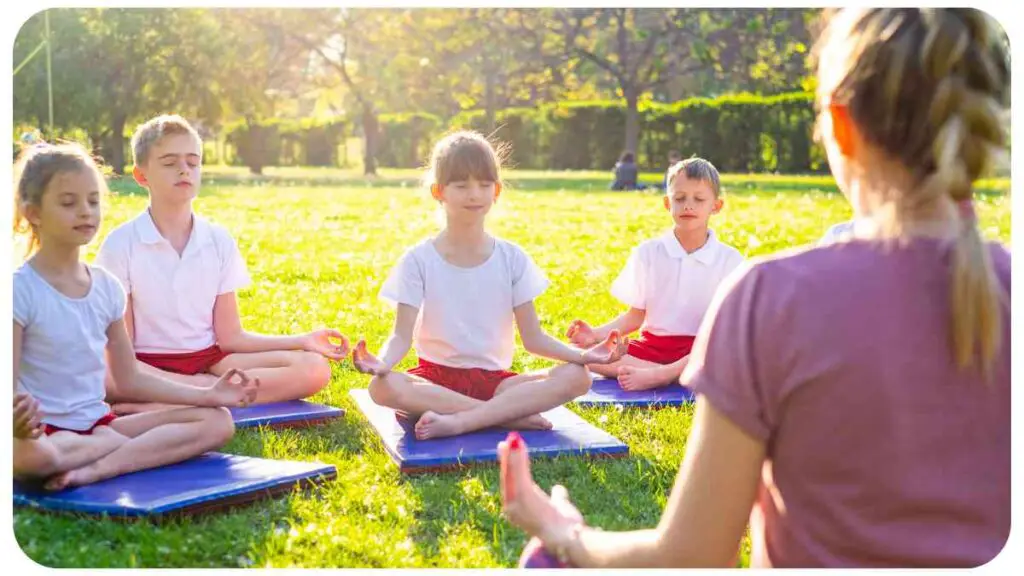
Connect with certified yoga teachers who specialize in teaching yoga to children. They can provide guidance on age-appropriate poses, modifications, and sequencing to ensure a safe and effective practice for your child.
10.2 Pediatric Occupational Therapists
If your child has specific sensory or motor challenges, consulting with a pediatric occupational therapist can be helpful. They can provide tailored strategies and adaptations to incorporate yoga and mindfulness into your child’s therapy goals.
10.3 Specialized Yoga Programs
Look for specialized yoga programs or studios that offer classes specifically designed for children with special needs or specific conditions. These programs may have instructors with expertise in adapting yoga for children with varying abilities.
10.4 Mental Health Professionals
If your child is experiencing emotional or behavioral difficulties, consulting with a mental health professional, such as a child psychologist or therapist, can help. They can guide you on incorporating mindfulness practices that align with your child’s therapeutic needs.
Remember, professionals in these fields can provide expert guidance, individualized recommendations, and ongoing support tailored to your child’s unique needs. They can help ensure a safe and enriching yoga and mindfulness practice experience for your child.
11. Final Thoughts
Engaging children in yoga and mindfulness can have numerous benefits for their physical, mental, and emotional well-being. By creating a supportive environment, incorporating these practices into daily routines, and adapting them to individual needs, you can set your child on a path towards a healthier and more balanced life.
Remember to lead by example, celebrate their progress, prioritize safety, and seek professional guidance when necessary. With your guidance and support, your child can experience the transformative power of yoga and mindfulness. Enjoy this journey of growth and self-discovery together!
Further Reading
Here are some recommended resources to explore further on the topic of yoga and mindfulness for children:
5 Yoga and Mindfulness Practices for Families: This article provides practical tips and activities for families to incorporate yoga and mindfulness into their daily lives, promoting well-being and connection.
Mindfulness for Kids: Discover the benefits of mindfulness for children and explore techniques and exercises specifically designed for their age group. Enhance their focus, self-awareness, and emotional regulation through these mindfulness practices.
5 Ways Kids Benefit from Yoga & Mindfulness: Learn about the various ways in which yoga and mindfulness can positively impact children’s physical, mental, and emotional well-being. This article provides insights into the benefits of these practices and how they can support children’s growth.
FAQs
How often should children practice yoga and mindfulness?
Consistency is important, but the frequency of practice depends on the child’s age, interests, and schedule. Aim for at least a few minutes of practice every day or a longer session a few times a week. Find a routine that works best for your child.
What age is appropriate for children to start practicing yoga and mindfulness?
Children as young as 3 years old can start engaging in age-appropriate yoga and mindfulness activities. As they develop, they can explore more challenging poses and techniques. Ensure the activities are fun, safe, and adjusted to their developmental stage.
Can children with physical disabilities or special needs practice yoga and mindfulness?
Yes, yoga and mindfulness can be modified to meet the specific needs of children with disabilities or special needs. Consult with professionals, such as certified yoga instructors or occupational therapists, who can provide guidance on adapting practices to suit individual abilities and requirements.
Are there online resources or apps available for children’s yoga and mindfulness?
Yes, there are several online resources and apps specifically designed for children’s yoga and mindfulness. Cosmic Kids Yoga, Smiling Mind, and GoNoodle are popular platforms offering interactive and engaging yoga and mindfulness content for children.
How can parents participate in their child’s yoga and mindfulness practice?
Parents can participate by practicing alongside their child, being their guide, and providing encouragement. Engaging in these practices together not only strengthens the parent-child bond but also allows parents to role model healthy habits and self-care practices.

Hello, my name is Hellen James! I am a yoga teacher and writer who loves to share information about how you can achieve a more fulfilling life. I have been practicing mindfulness, yoga, and meditation for over 10 years. My passion for these practices has led me to teach them to others.

